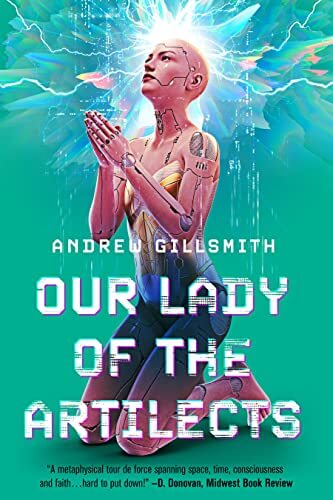In the far future, the world is troubled when Artilects, highly intelligent robots, begin receiving a vision of Mary. Is the vision real? Is it a clever hack? At first it’s just a strange curiosity, until one of these robots enters a church and asks for an exorcism.
Fr. Gabriel Serafian is sent to investigate, but the Church isn’t the only one interested in this phenomenon. The revived Hapsburg Empire, ruled by an elected Filipino Emperor, sends its elite agent, Praetor Namono Mbambu to conduct her own investigation. The exorcist and the bodyguard quickly uncover a conspiracy that could endanger the whole world. They are aided by two unexpected allies: a Sufi mystic, and an agent of the revived Caliphate, for this is a future where the Islamic Empire is a strong ally of the Christian Hapsburgs. As the heroes delve into the mystery further, they find that this conspiracy that threatens the world has its origins in an historic event that is actually happening in our present day: the ongoing genocide of the Uyghur population that only came to light in the wider world in 2020. The heroes soon find that the key to unlock the world’s salvation might just be Our Lady of Fatima. Then again, some interpretations of the third secret seem only to prophesy the world’s doom
If all of that sounds like a lot of worldbuilding, it most definitely is. Depending on your tastes as a reader, this will either be too much or exactly what you are craving. The film Valerian and the City of a Thousand Planets is a good example of the sort of setting you’re in for in this book that is part science fiction alternate history, and part political thriller.
The worldbuilding might be all sci-fi, but the pacing is pure thriller. The chapters from Praetor Namono especially are packed with fun fight scenes and action and make for a nice balance with Fr. Seraphian’s more cerebral journey. This butt-kicking African woman warrior quickly became my favorite character, despite her deep personal flaws. There is also quite a bit of heavy science discussed in Fr. Seraphian’s chapters, most of which I found difficult to comprehend. Yet this only added to the fun for me. If you enjoyed the mind-bending technology of The Three Body Problem by Cixan Liu, but want something that doesn’t subtly condone genocide, you’ll find this book a better alternative.
The diversity in this book is refreshing, with a cast from several different countries and settings from the Sahara, Europe, and China. However, there is one moment when Praetor Namono reacts a bit rudely to the caliph’s sister, mostly out of a sense of culture shock at her visit to the Caliph’s harem. This irritated me because I would think that any woman would feel compassion, not anger toward such women. But by the end of the story, Namono has overcome her pride and anger issues in a well-earned character arc. So, if Namono does rub you the wrong way at first, don’t let that put you off.
I found the interfaith friendships to be particularly refreshing, and a good demonstration of the values that modern Catholics and Muslims share, despite our tumultuous history. Once, conflict between Jews and Catholics similarly seemed inevitable, but now Jewish and Christian cultures are regarded as natural allies, so it’s not so unbelievable to suggest that this dynamic might change with Islam in the future. Of course, it is good and necessary to have a firm grasp of our differences as well, but I found this book a welcome relief to the usual manner that relationships between Muslims and Catholics are treated. It is also clear that the author has been praying for the plight of the Uyghurs, and the postscript notes that he will be giving a portion of the sales to the Uyghur Human Rights Project. This is a commendable example of Christian charity. This isn’t to say that the story acts as an apology for Islam. The scenes in the Caliph’s harem, for example, subtly condemn Islam’s treatment of women and sexual ethics.
However, if there is a serious issue I take with the book at all, it is only one single sentence in which a Catholic character, moved by the prayerful integrity of a Muslim friend, prays the Zikr Prayer, a Muslim meditative prayer. Both Catholic theologians and Muslim theologians agree that non-Muslims cannot validly pray Muslim prayers, but it is not the policy of this website to reject a book simply because a Catholic character is behaving imperfectly (we do that all the time don’t we?) but to accept or reject a book based on the overall worldview and message it sends. At the risk of spoiling the ending, the whole plot hinges upon the Catholic understanding of the sacramental reality, a belief that is innately anathema to Islam. However, because of the complexity of these ideas and the necessity of having a firm grasp of the differences and commonalities of our faith and Islam, I would not recommend this book to young readers without the guidance of an elder.
I should also note that some of the alternate history in the book involves the third secret of Fatima, which in Our Lady of the Artilects has been altered. This difference in the third secret seems to be the moment that Gillsmith’s alternate earth branches away from our own. However, there are still some actual Catholic conspiracy theorists out there who think the church never released the third secret. (You can read the full text of all three secrets on the Vatican’s website here) With that in mind, I would also not recommend this to anyone who might be prone to confusing fact and fiction. For regular fans of sci-fi and fantasy, however, it’s all a fun ride that will expand your imagination of God’s power in the world, and your compassion for all his children, be they Muslim, Catholic or even artificial life.




